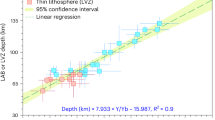Abstract
THE Brent crater (46° 04′ N., 78° 29′ W.) is cut into the Pre-Cambrian gneisses of central Ontario. On the surface the crater is marked by a poorly defined depression 18,000 ft. in diameter, with a sharply denned central crater 11,000 ft. in diameter and about 200 ft. deep. Drilling1 has shown that the central crater is partly filled with flat lying Ordovician strata underlain by a thick lens of brecciated Pre-Cambrian material. A hole drilled approximately in the centre of the structure1,2 passed through about 800 ft. of Ordovician strata, 1,900 ft. of breccia of various kinds, and beginning at a depth of 2,716 ft. penetrated breccia with a matrix of igneous textured trachyte for more than 100 ft. Below this “melt zone” brecciation died out very rapidly. Because of petrographic features found in the breccias, Brent has been widely accepted as a holotype of a “fossil” meteorite crater1–4. The Brent crater occurs on or near the Ottawa–Bonnechere graben, however, a major structure with a length of some hundreds of miles5, along which circular alkaline and carbonatitic complexes were intruded in Cambro–Ordovician time6,7. These facts suggest a possible endogenetic origin for the crater. In an attempt to resolve this problem we examined the petrographic and chemical composition of twenty-three samples of drill core from the central hole and nine samples collected on the surface. It was found petrographically that the samples fell into four groups. Underlying the Ordovician were about 100 ft. of breccias with substantial amounts of glass (often of several types), below which were 1,700 ft. of breccias with little or no glass. At a depth of 2,700 ft., 16 ft. of breccia rich in glass was again encountered grading into inclusion rich trachyte of igneous aspect. About 50 ft. of breccia rich in glass occurred below the trachyte, passing abruptly into relatively undeformed country rocks. A specimen from one of the dykelets cutting the breccia poor in glass was composed of extremely fine grained carbonates, minute needles of a pleochroic blue mineral and abundant opaque dust.
This is a preview of subscription content, access via your institution
Access options
Subscribe to this journal
Receive 51 print issues and online access
$199.00 per year
only $3.90 per issue
Buy this article
- Purchase on Springer Link
- Instant access to full article PDF
Prices may be subject to local taxes which are calculated during checkout
Similar content being viewed by others
References
Beals, C. S., Innes, M. J. S., and Rottenberg, J. A., The Solar System (edit. by Middlehurst and Kuiper), 4, 235 (The University of Chicago Press, 1961).
Dence, M. R., Meteoritics, 2, 249 (1964).
Short, N. M., J. Geol. Educ., 14, 149 (1966).
Gold, D. P., and Tuttle, O. F., Program, Conference on Shock Metamorphism of Natural Materials, Greenbelt, Md (April 16, 1966).
Kumarapeli, P. S., and Saull, V. A., Canad. J. Earth Sci., 3, 639 (1966).
Lumbers, S. B., Ontario Dept. Mines Prelim. Rep. 1964–6, 45 (1964).
Wanless, R. K., Stevens, R. D., Lachance, G. R., and Rimsaite, J. Y. H., Geol. Surv. Canada Paper, 65–17, 77 (1965).
McCall, G. J. H., Rep. Twentieth Intern. Geol. Cong., Merico, 405.
Holmes, A., and Harwood, H. F., Uganda Geol. Surv., Mem., 3, pt. 2, 185 analysis 109 (1937).
Petrology and Geochemical Features of Complexes of Ultrabasic, Alkaline and Carbonatite Rocks (edit. by Borodin, L. S.), 83, analysis 81 (1965).
Garson, M. S., Malawi Geol. Surv. Bull., 15, 21, 70.
Garson, M. S., Nyasaland Geol. Surv. Mem., 2, 169.
Eckermann, H. von, Sveriges Geol. Under. Series C, 36, 101 (1948).
Author information
Authors and Affiliations
Rights and permissions
About this article
Cite this article
CURRIE, K., SHAFIQULLAH, M. Carbonatite and Alkaline Igneous Rocks in the Brent Crater, Ontario. Nature 215, 725–726 (1967). https://doi.org/10.1038/215725a0
Received:
Revised:
Published:
Issue Date:
DOI: https://doi.org/10.1038/215725a0
This article is cited by
-
Non-random distribution of many terrestrial so-called impact structures and its implication
Naturwissenschaften (1978)
-
Lake Lappajarvi, Central Finland: a Possible Meteorite Impact Structure
Nature (1968)
-
Geochemistry of Some Large Canadian Craters
Nature (1968)
Comments
By submitting a comment you agree to abide by our Terms and Community Guidelines. If you find something abusive or that does not comply with our terms or guidelines please flag it as inappropriate.



